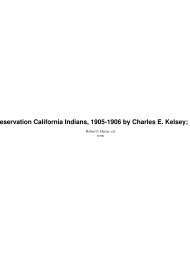YA summer '01 - Yosemite Online
YA summer '01 - Yosemite Online
YA summer '01 - Yosemite Online
You also want an ePaper? Increase the reach of your titles
YUMPU automatically turns print PDFs into web optimized ePapers that Google loves.
Joseph Grinnell's field notes from June, 1918.<br />
an offer in 1908 to create the Museum of Vertebrate<br />
Zoology at UC Berkeley. He directed it until his death in<br />
1939, realizing his dream and influencing generations of<br />
biologists in the areas of ecology, vertebrate systematics,<br />
and evolutionary biology.<br />
“What’s astonishing about Grinnell’swork—and the<br />
only reason we can do this resurvey now—is the extent to<br />
which he kept highly detailed records. His field notes are<br />
extraordinary,” said Moritz, an evolutionary biologist<br />
who specializes in lizards of the Australian rain forests.<br />
“He set up a whole system of taking field notes that’s<br />
been perpetuated through the history of the museum and<br />
has spread out to other places as well. What makes this<br />
museum special is that we have so much data per specimen,<br />
and it’s so well organized. That’s Grinnell’slegacy.”<br />
The National Science Foundation just awarded the<br />
museum a grant to put all the field notes of Grinnell and<br />
his colleagues on the Web in a searchable database. The<br />
notes themselves comprise 13,000 pages, and are accompanied<br />
by 2,000 photos and tens of thousands of specimens<br />
in the museum’s collections.<br />
Among Grinnell’s legacies was the first field survey of<br />
<strong>Yosemite</strong> National Park conducted at a time when the<br />
park’s unique and fragile habitat was feeling the pressure<br />
of increasing tourism. His survey led to recommendations<br />
for managing and preserving the park, among<br />
them, elimination of agriculture and removal of a small<br />
zoo from the valley.<br />
<strong>Yosemite</strong>’s Thompson said he keeps a copy of<br />
Grinnell’s published study near his desk and refers to it<br />
frequently.<br />
“Grinnell had a very prominent place in the development<br />
of science in the park service,” he said. He expects<br />
to make full use of the current survey.<br />
The <strong>Yosemite</strong> field notes once generated by Grinnell,<br />
Storer, and their team alone number 2,000 pages, and the<br />
combined team put in about 1,000 hours of field work in<br />
the park.<br />
“We’re going back through the field notes containing<br />
all the original information to do an exact comparison<br />
between today and eighty years ago, which is a remarkable<br />
thing,” said James Patton, who has been leading this<br />
<strong>summer</strong>’s survey teams. Patton is a curator in the<br />
museum, a UC Berkeley professor emeritus of integrative<br />
biology and an expert on small mammals.<br />
To make these comparisons, the team is revisiting initially<br />
about ten of the twenty-two sites surveyed by<br />
Grinnell and Storer within the boundaries of <strong>Yosemite</strong>.<br />
Assuming funding comes through, museum scientists<br />
will revisit the remainder of the twenty-two “Grinnell”<br />
sites in the park, plus add some new ones in the northern<br />
tier, an area of the park Grinnell did not visit.<br />
“Soon after I arrived at the museum (in 2000), I sat<br />
down and read a paper Grinnell wrote in 1910 on the<br />
uses of a research museum in which he laid out really,<br />
really clearly the purpose of building a museum the<br />
way he did,” Moritz said. “He actually specified that<br />
his hope was that future curators and zoologists could<br />
come back in 100 years and look at the effect of human<br />
changes to the landscapes on the vertebrate fauna. As<br />
soon as I read that, it was really clear what we had to do<br />
for our centenary —do what Grinnell told us to do and<br />
resurvey his transects.”<br />
While the earlier biologists used shotguns, leg-hold<br />
traps, and snap traps to do much of their surveying and<br />
Joseph Dixon, a student of Grinnell's, working in the field. Dixon<br />
later did extensive research work in the national parks.<br />
4 YOSEMITE ASSOCIATION, FALL 2003




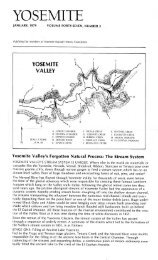
![(March 1982) [PDF] “We Are Pleased to Announce†- Yosemite Online](https://img.yumpu.com/51299748/1/190x242/march-1982-pdf-aeuroewe-are-pleased-to-announceaeur-yosemite-online.jpg?quality=85)
![[PDF] Old Horny, Yosemite's Unicorn Buck - Yosemite Online](https://img.yumpu.com/51269869/1/184x260/pdf-old-horny-yosemites-unicorn-buck-yosemite-online.jpg?quality=85)
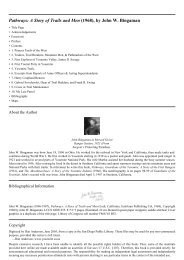
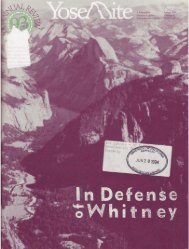
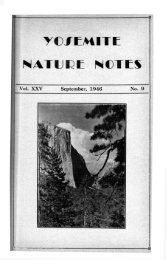
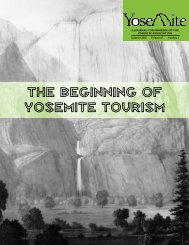
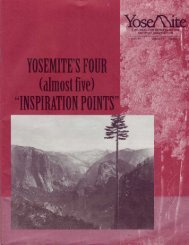
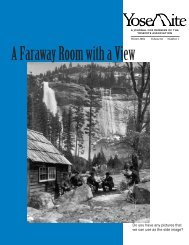
![1985 [PDF] - Yosemite](https://img.yumpu.com/48128837/1/184x260/1985-pdf-yosemite.jpg?quality=85)

